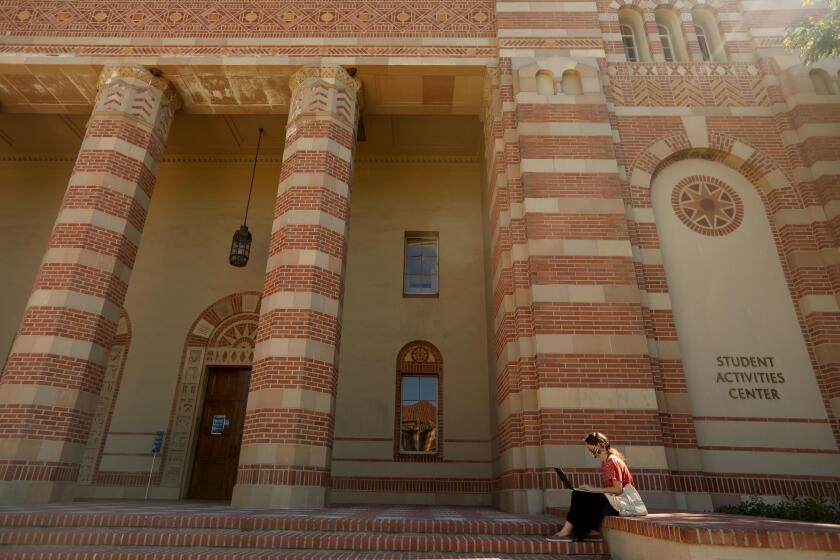Giant rock ends its journey to LACMA
- Share via
After an arduous, 105-mile journey from a dusty, remote Riverside quarry to the cultural heart of the Mid-Wilshire district, the Los Angeles County Museum of Art’s now-famous 340-ton granite boulder arrived safely at its new home before dawn Saturday.
It took 11 cold and grueling nights on the road navigating tight corners, “crabbing” across bridges and narrowly avoiding collisions with towering utility poles, but LACMA’s monolith arrived at exactly 4:25 a.m., illuminated by string lights and resting in a steel sling on its custom transporter.
Journalists from around the world and hundreds of onlookers, armed with cellphone cameras and noisemakers, turned out to welcome the big rock. LACMA Director Michael Govan stood in the center of Wilshire Boulevard, gazing up at the rock and beaming. “It looks a lot bigger in the city than it did in the quarry,” he said, shaking his head in disbelief.
The boulder might have arrived at LACMA several hours early if it weren’t for continual holdups caused by illegally parked cars along Wilshire that needed to be towed away. Remarkably, considering the logistical challenges involved in moving a nearly two-story-high chunk of granite through densely populated urban areas, there were no major mishaps.
It will take at least a month to dismantle the centipede-like transporter with 176 wheels and erect massive gantries needed to install the rock on rails spanning a 456-foot-long concrete slot near the museum’s Resnick Pavilion. There, it will form the center of artist Michael Heizer’s sculpture “Levitated Mass.” When it is completed, visitors will walk through the slot with the boulder suspended 15 feet overhead.
The complex and potentially dangerous project — which will cost up to $10 million, raised mostly from private donors — has elevated Govan’s profile even more as an influential advocate for artists, a fundraiser and a cultural leader in Los Angeles.
Govan, 49, who collects a salary of about $1 million a year, has been LACMA director since 2006. At that time, LACMA was regarded as a lackluster performer compared with metropolitan museum expansion and renovation plans unfolding in Chicago, Boston and Philadelphia.
Not anymore. Govan has transformed the museum and its reputation. He has overseen completion of two new exhibition halls, expanded the collection by more than 12,000 objects and helped double annual attendance.
“Now this rock has taken the region by storm,” said Los Angeles County Supervisor Zev Yaroslavsky. “People can love it or hate it, but they are all consumed by it. It has the whole town talking, which is what art is supposed to do.”
Terry Semel, co-chairman of the LACMA Board of Trustees and one of the donors to the rock project, said: “A million dollars a year is not enough for Michael. We’re really blessed to have him.”
Govan probably wouldn’t argue with any of that. “I was hired as a museum builder who would stick around for more than five years,” said Govan, who had shepherded nearly a dozen previous museum building and expansion projects across the country. “One of the first things I did was lay out a long-range vision, and its first art effort was ‘Urban Light.’”
The 4-year-old forest of vintage lampposts that makes up Chris Burden’s sculpture at LACMA’s entrance on Wilshire has become a cultural symbol of Los Angeles, appearing as the setting for hundreds of Flickr albums and magazine shoots, countless wedding photographs and “Valentine’s Day,” an L.A.-centric romantic comedy movie.
Heizer’s sculpture, Govan said, will add a “magical and super modern” ambience that “conjures imagery of Western landscapes of flat open spaces and massive mountains, ancient obelisks and geometrical constructs.”
“They would never have let me do this in New York,” Govan added with a laugh, “which is only one of the things I love about Los Angeles.”
In retrospect, the project was “much harder and took much longer than I thought,” Govan said. “After all, it has been six years since Heizer called me from an airport and said, ‘I found the stone for “Levitated Mass.” Want it?’ My response: ‘Of course!’”
The rock itself cost the museum $70,000.
What followed were years of engineering, logistics planning, fundraising and negotiations with city, county and state officials for more than 100 permits needed to cross jurisdictions.
The rock was hauled from the Stone Valley Quarry to LACMA on a 200-foot-long transporter specially built by the Oregon-based company Emmert International. Along the way, the bright red vehicle with a top speed of 8 mph awed motorists as it crawled by night, maneuvering through a series of obstacles and surprising encounters.
The first night’s journey took a roundabout route designed to avoid a bridge with Caltrans weight restrictions. The rock crept beneath an overpass in Chino with only 6 inches of clearance. It was celebrated with a block party in Long Beach’s Bixby Knolls neighborhood, then squeezed through the middle of a road with only 2 inches of space between the curb and the wheels of the transporter.
The boulder began the last leg of its journey from a stop at Figueroa Street between 63rd and 65th Streets, passing landmarks including the Coliseum, Exposition Park, the Wiltern Theatre, the La Brea Tar Pits and LACMA’s own “Urban Light.”
It arrived at LACMA more than six months behind schedule. Conspicuously absent at the welcoming party was Heizer, a famously reclusive artist.
After the rock is positioned above the slot in the ground, landscaping of the surrounding area will begin. The museum doesn’t expect the exhibit to be ready until late spring or early summer.
Emmert engineer Mark Voss, who designed the transporter, was a bit teary-eyed at the thought of dismantling his masterpiece. “I’m kind of sad to take it apart,” he said. “Yeah. It was a really cool transporter.”
More to Read
Sign up for Essential California
The most important California stories and recommendations in your inbox every morning.
You may occasionally receive promotional content from the Los Angeles Times.












